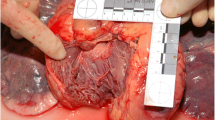Summary
In 10 to 66% blunt chest traumata lead to cardiac traumata. As it is shown in our special collective (n = 12) injuries of the pericardial sac of the myocardium, of the myocardial septum, of the coronary arteries and of the cardiac valves have occured. Therefore clinical symptoms are various and the diagnosis remains difficult with regard to the causative polytrauma. Bleedings and/or pericardial tamponade caused by rupture of the atrial or ventricular wall, injury of main coronary vessels or cardiac dislocation after pericardial rupture urgently require a surgical intervention. Aneurysms caused by blunt trauma, ventricular septal defects, valve insufficiencies may be mostly treated in the interval.
Zusammenfassung
Stumpfe Thoraxtraumen führen in 10–66 % zu einer Schädigung des Herzens. Wie das eigene Krankengut (n = 12) zeigt, sind Verletzungen des Perikards, des Myokards, des Septums, der Coronargefäße und der Herzklappen möglich. Die klinischen Symptome sind daher vielfältig und die Diagnose ist im Rahmen des zumeist ursächlichen Polytraumas häufig schwierig zu stellen. Dringliche Indikation zur Operation ist die Blutung bzw. die Perikardtamponade als Folge einer Herzwandruptur, die Herzluxation nach großen Perikardeinrissen und die Verletzung eines Hauptcoronararterienastes. Stumpf traumatisch bedingte Aneurysmen, Ventrikelseptumdefekte und Klappeninsuffzienzen können in der Mehrzahl im Intervall operiert werden.
Similar content being viewed by others
Literatur
Bircks W (1983) Stumpfes Herztrauma. In: Carstensen G (Hrsg) Intra- und postoperative Komplikationen. Springer, Berlin Heidelberg New York
Bodin L, Rouby JJ, Viars P (1985) Frequency of myocardial contusion after blunt chest trauma as evaluated by Thallium 201 scintigraphy. Anesthesiology 63:123 (Supplement)
Bright EF, Beck CS (1935) Non penetrating wounds of the heart. Clinical and experimental study. Am Heart J 10:293–321
Clark DE, Wiles CS III, Lim MK, Durham CM, Rodriguez A (1983) Traumatic rupture of the pericardium. Surgery 93:495–503
Flejou Y, Roland E, Ecoiffier J (1979) The place of angiography in the evaluation of traumatic injuries of the heart and coronary arteries. Cardiovasc Radiol 2:47–50
Glinz W (1978) Thoraxverletzungen. Springer, Berlin Heidelberg New York
Miller FA Jr, Seward JB, Gersh BJ, Tajik AJ, Mucha P Jr (1982) Two-dimensional echocardiographic findings in cardiac trauma. Am J Cardiol 50:1022–1027
Schulte HD, Bircks W, Krian A (1979) Traumatische Herzruptur. Herz/Kreislauf 11:451–456
Williams JB, Silver DG, Laws HL (1981) Successful management of heart rupture from blunt trauma. J Trauma 21:534–537
Author information
Authors and Affiliations
Rights and permissions
About this article
Cite this article
Winter, J., Schulte, H.D., Irlich, G. et al. 21. Klinik und Therapie des stumpfen Herztraumas. Langenbecks Arch Chiv 369, 139–144 (1986). https://doi.org/10.1007/BF01274338
Issue Date:
DOI: https://doi.org/10.1007/BF01274338




